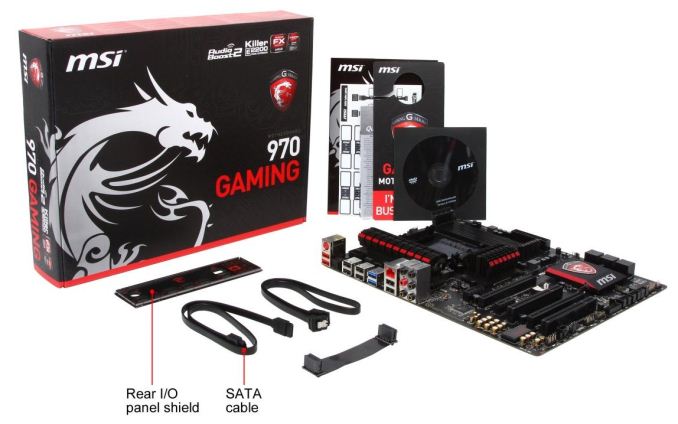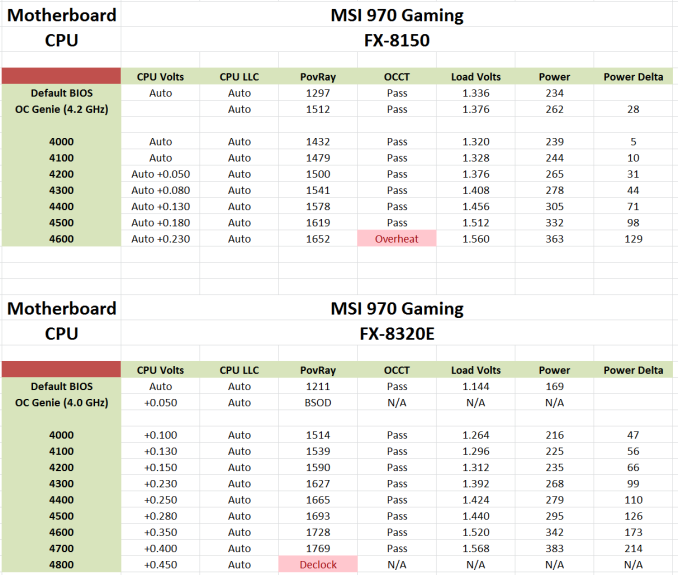MSI 970 Gaming Motherboard Review: Undercutting AM3+ at $100
by Ian Cutress on January 22, 2015 10:00 AM EST- Posted in
- Motherboards
- AMD
- MSI
- Vishera
- AM3+
MSI 970 Gaming In The Box
Gaming motherboards should be at the heart of user experience – gamers want to play games and have a fun while they do it, and MSI recognized this back in 2013 and went all in with their Gaming ecosystem. This applies to gifts, goodies, styling, logos, and potentially motherboard in-box bundles. The only question is what would the average MSI motherboard user want? In the past we have seen posters and door hangers, which might be suited to the under-25s, but many users are over 25 and want something more subtle.
In the MSI 970 Gaming we get the following:
Driver DVD
Manuals
Rear IO Shield
Cable adhesives
Door Hanger
Two SATA Cables
Flexi SLI Bridge
Adhesive MSI Gaming badge for the case (not pictured)
While we get the door hanger, the poster is gone and the adhesive shield becomes a plus point in the general user designing a gaming system. In the same way that buying a CPU comes with a small sticker, and sometimes buying memory does as well, this allows the user to adorn their rig with an indication of the components inside.
Many thanks to...
We must thank the following companies for kindly providing hardware for our test bed:
Thank you to OCZ for providing us with PSUs and SSDs.
Thank you to G.Skill for providing us with memory.
Thank you to Corsair for providing us with an AX1200i PSU.
Thank you to MSI for providing us with the NVIDIA GTX 770 Lightning GPUs.
Thank you to Rosewill for providing us with PSUs and RK-9100 keyboards.
Thank you to ASRock for providing us with some IO testing kit.
Thank you to Cooler Master for providing us with Nepton 140XL CLCs.
Test Setup
For our testing, in order to provide a direct comparison with the other AMD 900 series motherboards we have tested (a big five board roundup and the 990FX Extreme9), we dusted off our old FX-8150 CPU for the bulk of our testing. As the motherboard was supplied with the FX-8320E, which we reviewed in our AMD testing motherboard, we have also included overclocking results for this in a comparison to the CPU review as well.
| Test Setup | |
| Processor | AMD FX-8150 4 Modules, 8 Threads, 3.6 GHz / 4.2 GHz Turbo |
| Motherboards | MSI 970 Gaming |
| Cooling | Cooler Master Nepton 140XL |
| Power Supply | OCZ 1250W Gold ZX Series Corsair AX1200i Platinum PSU |
| Memory | G.Skill RipjawsZ 4x4 GB DDR3-1866 9-11-9 Kit |
| Memory Settings | DDR3-1866 8-9-9 |
| Video Cards | MSI GTX 770 Lightning 2GB (1150/1202 Boost) |
| Video Drivers | NVIDIA Drivers 337 |
| Hard Drive | OCZ Vertex 3 |
| Optical Drive | LG GH22NS50 |
| Case | Open Test Bed |
| Operating System | Windows 7 64-bit SP1 |
| USB 2/3 Testing | OCZ Vertex 3 240GB with SATA->USB Adaptor |
MSI 970 Gaming Overclocking
Experience with MSI 970 Gaming
As mentioned in the BIOS section of the review, MSI has somewhat crippled the overclocking options on the motherboard by not implementing any form of load line calibration or literal CPU voltage values. All the user has to go by is the CPU voltage offset and pump this up to overcome any voltage drop across the CPU. This causes our results with the FX-8320E to be 100 MHz less than in our CPU review motherboard due to overheating on the basis of raised voltages.
On the automatic overclocking front, OC Genie passed with the FX-8150 but when the FX-8320E was used, the voltage was not sufficient to boot into the OS.
Methodology
Our standard overclocking methodology is as follows. We select the automatic overclock options and test for stability with PovRay and OCCT to simulate high-end workloads. These stability tests aim to catch any immediate causes for memory or CPU errors.
For manual overclocks, based on the information gathered from previous testing, starts off at a nominal voltage and CPU multiplier, and the multiplier is increased until the stability tests are failed. The CPU voltage is increased gradually until the stability tests are passed, and the process repeated until the motherboard reduces the multiplier automatically (due to safety protocol) or the CPU temperature reaches a stupidly high level (100ºC+). Our test bed is not in a case, which should push overclocks higher with fresher (cooler) air.
Overclock Results












37 Comments
View All Comments
Gigaplex - Thursday, January 22, 2015 - link
Instead of spending that money on a new CPU and motherboard, spend it on a GPU instead to get better BF4 performance.Phartindust - Thursday, January 29, 2015 - link
Exactly, use that money towards a R9 290x, 290.tekphnx - Friday, January 23, 2015 - link
I generally agree, but I would say that the $99 FX-6300 and the $115 OEM FX-8310 would be the exceptions that actually stand out as good values from the red team right now - particularly when paired with a 970 board and boosted with a moderate overclock into the ~4.5 ghz range, these chips offer more value vs. the similarly-priced i3 series, albeit with higher power consumption and lacking an upgrade path.rafaelluik - Tuesday, February 24, 2015 - link
What more value? Haswell i3 beats even FX 8350 in 99% of games and beats the FX9590 in 90% of them!TeXWiller - Thursday, January 22, 2015 - link
I took the upgrade dive as due to a offering on 125W fx8370. As I run only at stock speeds, my experience might not be relevant to you. The single module max turbo takes little less power than the 95W thuban with turbo and is faster with modern software, marginally slower on very old test software. I sometimes still launch UT2k4 and the speed improvement is significant. A software 4k 60Hz video playback got 70% improvement. Reflecting this, I wouldn't go near anything slower than the models running at least 4GHz base speed as an upgrade.duploxxx - Thursday, January 22, 2015 - link
looking at figures and benchmarking you are right. but when you look a bit further on general platforms single gpu its not that big difference at all and some even none existing. with examples like 85-95 fps you won't even notice the difference if you would run on ore another.http://www.anandtech.com/show/8427/amd-fx-8370e-cp...
Penti - Thursday, January 22, 2015 - link
Does it matter? AMD has intentionally not released new BD-products or updated chipsets for non-APU and server products. They are not counting on selling broken Bulldozers. They have put their resources on the new architectures instead. You can continue to use an AMD-system if your demands aren't too high, new stuff will come there just isn't any sense buying one today. Buying AMD graphics might not be an easy sell these days either, but R9-290 is still decent and new stuff will come hopefully with HDMI 2.0 support and all that.piroroadkill - Friday, January 23, 2015 - link
" the IPC improvements from Phenom II to current FX chips is marginal at best."I thought it was actually the reverse. I definitely recall seeing the old high end Phenom II X6 outpeform the new Bulldozer chips when they first hit.
Yep: http://www.anandtech.com/show/4955/the-bulldozer-r...
ShieTar - Friday, January 23, 2015 - link
Sure, but there is a difference in IPC between "When Bulldozer first hit" and "current FX":http://anandtech.com/bench/product/1280?vs=700
Phartindust - Thursday, January 29, 2015 - link
The difference is larger than you think:http://anandtech.com/bench/product/102?vs=697